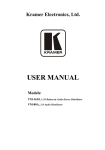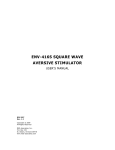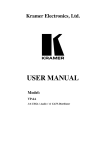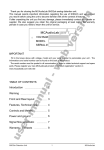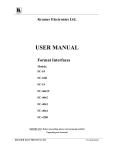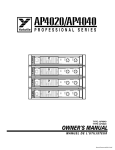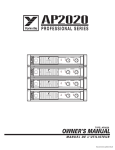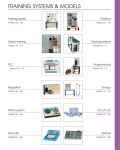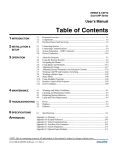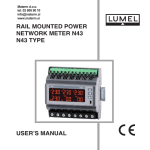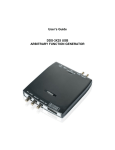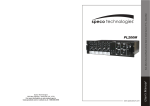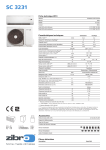Download User Manual for Distribution Amplifiers - AV-iQ
Transcript
KRAMER ELECTRONICS, Ltd. USER MANUAL Distribution Amplifiers: Models: VM-1110, VM-1610, VM-5AD, VM-80A IMPORTANT: Before proceeding, please read paragraph entitled "Unpacking and Contents" Table Of Contents Section Name Page 1 1.1 1.2 2 3 4 4.1 5 5.1 5.2 5.3 5.4 6 6.1 7 8 8.1 8.2 8.3 8.4 8.4.1 8.5 8.6 8.7 9 10 10.1 10.2 INTRODUCTION A Word On Distribution Amplifiers Factors Affecting Quality of Results SPECIFICATIONS How do I Get Started? UNPACKING AND CONTENTS Optional Accessories VM SERIES AMPLIFIERS Getting to Know Your VM-1110 Amplifier Getting to Know Your VM-1610 Amplifier Getting to Know Your VM-5AD Amplifier Getting To Know Your VM-80A Amplifier INSTALLATION Rack Mounting Connecting to Audio Devices USING THE VM AUDIO AMPLIFIERS Powering On the Amplifier Coupling Audio Control (VM-1610/80A Only) Balanced\Stereo Control (VM-5AD Only) Using A Microphone Programming the VM-1110 and VM-1610 Programming the VM-80A Audio System Setup TAKING CARE OF YOUR AUDIO AMPLIFIER TROUBLESHOOTING Power and Indicators Audio Signal 2 2 2 3 4 4 4 5 5 6 7 9 9 9 9 9 9 9 9 9 10 10 10 10 11 11 12 13 Figure 1 2 3 4 5 List Of Illustrations VM-1110 Front/Rear Panel Features VM-1610 Front/Rear Panel Features VM-5AD Front/Rear Panel Features VM-80A Front/Rear Panel Features Audio System Setup Page 5 6 7 8 11 List Of Tables Table 1 2 3 4 VM-1110 Front/Rear Panel Features VM-1610 Front/Rear Panel Features VM-5AD Front/Rear Panel Features VM-80A Front/Rear Panel Features 5 6 7 8 INTRODUCTION Congratulations on your purchase of this Kramer Electronics amplifier. Since 1981 Kramer has been dedicated to the development and manufacture of high quality video/audio equipment. The Kramer line has become an integral part of many of the best production and presentation facilities around the world. In recent years, Kramer has redesigned and upgraded most of the line, making the best even better. Kramer’s line of professional video/audio electronics is one of the most versatile and complete available, and is a true leader in terms of quality, workmanship, price/performance ratio and innovation. In addition to the Kramer line of high quality amplifiers, such as the one you have just purchased, Kramer also offers a full line of high quality switchers, processors, interfaces, controllers and computer-related products. This manual includes configuration, operation and information for the following products from the Kramer VM line of distribution amplifiers. All these VM amplifiers are similar in operation and features. VM-1110 – 1:10 Balanced Mono or 2x5 Stereo Audio Distributor VM-1610 – 1:10 or 2x1:5 Balanced Stereo Audio Distributor VM-5AD- 1:5 Balanced Mono/Unbalanced Stereo Audio Distributor VM-80A- 1:8 or 2x 1:4 Balanced Stereo Audio Distributor 1.1 A Word On Distribution Amplifiers Distribution amplifiers are used to distribute one source to several acceptors for simultaneous recording or monitoring of one source, with no discernible signal degradation. They vary in the number of inputs, programming capability, number of outputs and operating format. A good quality distribution amplifier amplifies the incoming signal, pre-compensates the signal for potential losses (resulting from the use of long cables, noisy source, etc.) and generates several identical buffered and amplified outputs. Often, a signal processor is inserted between the source and the distribution amplifier for correction and fine-tuning of the source signal before multiplication, so that all outputs are corrected in the same way. 1.2 Factors Affecting Quality of Results There are many factors affecting the quality of results when signals are transmitted from a source to an acceptor: Connection cables - Low quality cables are susceptible to interference, they degrade signal quality and cause elevated noise levels. They should therefore be of the best quality. Sockets and connectors of the sources and acceptors - So often ignored, they should be of highest quality, since "Zero Ohm" connection resistance is the target. Sockets and connectors also must match the required impedance (75 ohms in video). Cheap, low quality connectors tend to rust, thus causing breaks in the signal path. Amplifying circuitry - Must have quality performance when the desired end result is high linearity, low distortion and low noise operation. Distance between sources and acceptors - Plays a major role in the final result. For long distances (over 15 meters) between sources and acceptors, special measures should be taken in order to avoid cable losses. These include using higher quality cables or adding line amplifiers. Interference from neighboring electrical appliances - These can have an adverse effect on signal quality. Balanced audio lines are less prone to interference, but unbalanced audio should be installed far from any mains power cables, electric motors, transmitters, etc. even when the cables are shielded. SPECIFICATIONS VM-1110 VM-1610 VM-5AD VM-80A Configuration 1:10 or 2x1:5 1:10 or 2x1:5 1:5 Input Type 2 balanced audio 2 stereo balanced audio Input Connections Female XLR connectors Terminal block connectors 1 audio-balanced 2 stereo audio balanced mono, or unbalanced stereo. MIC state: 1 balanced mono Mic or unbalanced stereo Mic - 5mV/10kohm. Female XLR Terminal block connectors connectors Input Level +4dBm 50kohm Up to +24dBm/50Kohm Output Type 10 (or 2x5) stereo balanced audio Output Connector 10 balanced audio (5 stereo balanced audio) Male XLR connectors Output Level +4dBm/50ohm Output Coupling AC 1:8 or 2x1:4 Up to 18Vpp/50Kohm MIC state: 5mV/10kohm 5 mono balanced or stereo unbalanced audio Male XLR connectors 8 (or 2 x 4) stereo balanced audio Up to +24dBm/50ohm AC Up to 20Vpp/50ohm +4dBm, 49ohm AC AC Audio S/N Ratio >95dB@1Vpp >92dB@1Vpp >88dB@1Vpp 100dB@1Vpp Audio Bandwidth 10-100kHz, -3dB 10-100kHz, -3dB 10-80kHz, -3dB 10-20kHz, -1dB Channel Matching 60dB 60dB >60dB -65dB Max audio Output >20Vpp 26Vpp 20Vpp 20Vpp Audio THD <0.1% at 1kHz 0.011% at 1kHz <0.02% at 1kHz Gain Range 0.5 to 9.4dB <0.011% at 1kHz 0.5dB to 9.5dB 15.5dB to 35.6dB 0.2 to 5.8dB Crosstalk -62dB -84.5dB NA -60dB Controls Front selector switches for 1:10 or 2x1:5 operation Dimensions (W, D, H) 48.3 x 17.8 x 4.5(cm) 19" x 7" x 1U 2.5 kg (5.5 lbs.) Approx. Front panel selectors for 1:10 or 2x1:5 operation(4 trimmers - two for each input channel) 48.3 x 17.8 x 4.5(cm) 19" x 7" x 1U 2.6 kg (5.7 lbs.) Approx. Front panel Front panel selectors stereo/balance and for 1:8, 2x1:4, Mic/line pushbuttons operation, 4 front accessible balanced gain trimmers 24.5 x 18 x 4.5 (cm) 22 x 18 x 4.5 (cm) 9.6" x 7" x 1.8" 8.7 " x 7" x 1.8" 1.2kg. (2.7 lbs.) Approx. 1.2kg. (2.7 lbs.) Approx. Power Consumption 3.2VA 21VA 3.4VA 6.7VA Power Source 230/115VAC, 50/60Hz(115V U.S.A.) 230/115VAC, 50/60Hz(115V U.S.A.) 230/115VAC, 50/60Hz(115V U.S.A.) 230/115VAC, 50/60Hz(115V U.S.A.) Weight Terminal block connectors +4dBm, 100kohm Terminal block connectors HOW DO I GET STARTED? The fastest way to get started is to take your time and do everything right the first time. Taking 15 minutes to read the manual may save you a few hours later. You don’t even have to read the whole manual, focus on the relevant sections. UNPACKING AND CONTENTS The items contained in your Kramer VM amplifier package are listed below. Please save the original box and packaging materials for possible future transportation and shipment of the amplifier. Amplifier AC power cable User manual Rubber feet Kramer concise product catalog 4.1 Optional Accessories The following Kramer accessories can enhance implementation of your amplifier. Rack Adapter - Used to install smaller size machines in a standard 1U rack. One or more machines may be installed on each adapter. SP-4200 - (Audio ProcAmp) - can be serially connected between a VM- amplifier and the audio source for noise reduction sound improvement. The machine provides full stereo signal processing as follows: Noise Reduction by up to 25dB from any source without sonic artifacts, downward audio expansion, dynamically adjusting adaptive threshold for all-level operation, effective Dolby B(R) decoding, AGC operation and level transcoding. FC-4208 - (Balanced/Unbalanced Audio Transcoder) can be serially connected between a VMamplifier and the audio source for audio conversion of different formats. The machine is a bidirectional Transcoder between two popular audio formats. It allows gain or attenuation while transcoding to compensate for the 14dB change between IHF audio levels and the newly adopted, balanced DAT input levels. Very low noise and distortion components are used throughout. VM SERIES AMPLIFIERS This section describes all the controls and connections of your amplifier. Understanding all of the controls and connections helps you realize its full power. 5.1 Getting to Know Your VM-1110 Amplifier The KRAMER VM-1110 is a full spec, state-of-the-art, 1:10 balanced audio distribution amplifier designed for studio and other demanding applications. The VM-1110 splits the input source into ten identical outputs with no discernible signal degradation. The VM-1110 has two inputs and can be programmed by the user to function as a 1:10 Mono DA or as a 2 x 1:5 (stereo) DA. State-of-the-art Bi-Fet amplifying circuitry and a high power discrete buffering system make the VM-1110 an excellent performer. All circuitry is active with no transformers thus ensuring hum-free, full bandwidth operation. The VM-1110 may also be used to distribute unbalanced signals, using an appropriate adapter and grounding the negative polarity signal. Two VM-1110 machines can be used for 1:10 stereo operation, in conjunction with the KRAMER VM-1010 (used for video). Front/rear panel features of the VM-1110 are described in Figure 1 and Table 1. NOTE For operation instructions refer to section 8. Figure 1: VM-1110 Front/Rear Panel Features Table 1: VM-1110 Front/Rear Panel Features No. Feature 1. 2. Illuminated power switch Mode 1:10 pushbutton (Illuminates when pushed) Mode 2 x1:5 pushbutton (Illuminates when pushed) XLR INPUT A female connector XLR INPUT B female connector XLR OUT 1A-5A male connectors XLR OUT 1B-5B male connectors A 3-prong power connector/fuse 3. 4. 5. 6. 7. 8. Function Supplies power to the unit. Splits input "A" to all 10 outputs when pressed. Splits inputs "A" and "B" to outputs "1A-5A" and "1B-5B" respectively when pressed. Audio input Audio input 5 amplified and buffered audio outputs. 5 amplified and buffered audio outputs. A 3-prong AC connector allows power to be supplied to the unit. Directly underneath this connector, a fuse holder houses the appropriate fuse. 5.2 Getting to Know Your VM-1610 Amplifier The KRAMER VM-1610 is a full spec, state-of-the-art, 1:10 balanced stereo audio distribution amplifier designed for studio and other demanding applications. The VM-1610 has two inputs and can be programmed by the user to function as a 1:10 or as a 2 x 1:5 DA. State-of-the-art Bi-Fet amplifying circuitry and a high power discrete buffering system make the VM-1610 an excellent performer. All circuitry is active with no transformers thus ensuring hum-free and full bandwidth operation. Front/rear panel features of the VM-1610 are described in Figure 2 and Table 2. NOTE For operation instructions refer to section 8. Figure 2: VM-1610 Front/Rear Panel Features Table 2: VM-1610 Front/Rear Panel Features No. Feature 1. 2. Illuminated power switch CH 2 LEVEL (Left) Gain trimmer 3. 4. CH 2 LEVEL (Right) Gain trimmer MODE 1:10/2x1:5 selector 5. CH 1 LEVEL (Left) Gain trimmer 6. CH 1 LEVEL (Right) Gain trimmer CHANNEL 1 OUT 1-5 (L,R) terminal block connector CHANNEL 1 INPUT (L,R) terminal block connector CHANNEL 2 INPUT (L,R) terminal block connector CHANNEL 2 OUT 1-5 (L,R) terminal block connector A 3-prong power connector/fuse 7. 8. 9. 10. 11. Function Supplies power to the unit. Controls the left channel audio gain (the machine is factory preset for accurate 1:1 signal transparency). Controls the Right channel audio gain (the machine is factory preset for accurate 1:1 signal transparency). 1:10 (released): Splits channel "1" input to all 10 outputs. 2x1:5 (pressed): Splits channel "1" and channel "2" " to outputs "1-5" of channels "1" and "2" respectively. Controls the left channel audio gain (the machine is factory preset for accurate 1:1 signal transparency). Controls the Right channel audio gain (the machine is factory preset for accurate 1:1 signal transparency). 5 amplified and buffered audio outputs. Stereo audio balanced input. Stereo audio balanced input. 5 amplified and buffered audio outputs. A 3-prong AC connector allows power to be supplied to the unit. Directly underneath this connector, a fuse holder houses the appropriate fuse. 5.3 Getting to Know Your VM-5AD Amplifier The KRAMER VM-5AD is a full spec, state-of-the-art, 1:5 balanced audio distribution amplifier designed for studio and other demanding applications. The VM-5AD splits a single input source, either mono balanced or stereo unbalanced into five identical outputs without any discernible signal degradation. The VM-5AD has an audio level control knobs to change balanced or unbalanced audio signal levels, it can accept microphone input level, balanced mono or unbalanced stereo, amplifying it to a line level signal. The VM-5AD allows easy conversion between balanced and unbalanced signals for maximal flexibility in studios. All circuitry is active with no transformers, thus ensuring humfree, full bandwidth operation. The VM-5AD may be used to convert balanced signal levels and unbalanced signal levels in both directions, using the level knobs. A microphone signal (balanced/unbalanced) may be converted to a standard +4dBm balanced level. Front/rear panel features of the VM-5AD are described in Figure 3 and Table 3. NOTE For operation instructions refer to section 8. Figure 3: VM-5AD Front/Rear Panel Features No. 1. 2. 3. 4. 5. 6. 7. 8. Table 3: VM-5AD Front/Rear Panel Features Feature Function Illuminated Power Switch Supplies power to the unit. LEVEL R knob Adjusts right stereo audio level when Stereo/BAL pushbutton is in “Stereo” position. LEVEL L/BAL knob 1. Adjusts left stereo audio level when Stereo/BAL pushbutton is in “Stereo” position. 2. Adjusts balanced audio level when Stereo/BAL is in “BAL” position. Mic/Line pushbutton. 1. Should be pressed (“Mic” position) whenever microphone is used. 2. Should be released (“Line” position) for normal operation (no microphone). Stereo/BAL pushbutton 1. Enables stereo signal and should be pressed (“Stereo” position) when a stereo signal is applied to the input. 2. Enables balanced signal and should be released (“Bal” position) when a balanced signal is applied to the input. XLR INPUT female connector XLR OUT1- OUT5 male connectors 3-prong power connector/fuse Audio input 5 amplified and buffered audio outputs. A 3-prong AC connector allows power to be supplied to the unit. Directly underneath this connector, a fuse holder houses the appropriate fuse. 5.4 Getting To Know Your VM-80A Amplifier The KRAMER VM-80A is a Broadcast quality, state-of-the-art, balanced stereo audio distribution amplifier designed for demanding applications, such as broadcast and production studios. The VM80A has two balanced stereo audio inputs, each splitting the input source into four identical outputs. The VM-80A can function as a 1:8 DA or as two 1:4 DAs. It has trimmers on the front panel to fine tune levels of each channel individually. Units in the 80 series come in a convenient, compact size enclosure. Any two units fit side by side in a 19" rack using a special 1U-rack adapter. To achieve a larger distribution system, the inputs of several machines may be looped by a parallel connection. For signal enhancement and noise reduction, an audio signal processor may be inserted. Front/rear panel features of the VM-80A are described in Figure 4 and Table 4. NOTE For operation instructions refer to sections 8.1, 8.6. Figure 4: VM-80A Front/Rear Panel Features Table 4: VM-80A Front/Rear Panel Features No. 1. 2. 3. 4. 5. 6. 7. 8. 9. 10. 11. 12. Feature Function Illuminated Power Switch 1:8 operating mode touch switch (Illuminated when pressed) 2x1:4 operating mode touch switch (Illuminated when pressed) CH 2 LEVEL Left trimmer CH 2 LEVEL Right trimmer CH 1 LEVEL Left trimmer CH 1 LEVEL Right trimmer CH 1 IN (L,R) terminal block connector CH 2 IN (L,R) terminal block connector CH 2/1 OUTPUTS (L,R) terminal block connectors CH 1 OUTPUTS (L,R) terminal block connectors Power Connector Supplies power to the unit. Splits channel "1" input to all 8 outputs (channels "1"&"2")when pressed. Splits channels "1"&"2" inputs to output channels "1"&"2" respectively when pressed. Controls Channel "2" (left) audio gain. Controls Channel "2" (Right) audio gain. Controls Channel "1" (left) audio gain. Controls Channel "1" (Right) audio gain. Stereo audio balanced input. Stereo audio balanced input. Amplified and buffered audio outputs. Amplified and buffered audio outputs. A 3-prong AC connector allows power to be supplied to the unit. Directly underneath this connector, a fuse holder houses the appropriate fuse. INSTALLATION 6.1 Rack Mounting The VM-1110 and VM-1610 amplifiers may be rack mounted in a standard 19” EIA rack assembly, and include rack “ears” at the ends of the front panel. Each of these devices uses one unit (1U) of rack height, 1.75", and does not require any specific spacing above or below the unit for ventilation. To mount these amplifiers, simply place the unit against the rails of your rack, and insert standard screws through each of the four corner holes in the rack ears. The VM-80A and VM-5AD amplifiers require a special (see section 4.1) rack adapter (contact your KRAMER dealer) to be mounted in the 1U rack. For installation of the VM-80A and VM-5AD, follow the instructions, in the installation guide, enclosed with the adapter. CONNECTING TO AUDIO DEVICES Audio sources and output devices (such as amplifiers or recorders) may be connected to the amplifier through the female XLR type connectors (VM-1110 and VM-5AD models), or through terminal block type connectors (VM-1610 and VM-80A models) located at the back of the machine. USING THE VM AUDIO AMPLIFIERS 8.1 Powering On The Amplifier NOTES 1. The amplifier should only be powered on after all connections are completed and all source devices have been powered on. Do not attempt to connect or disconnect any audio or control signals to the amplifier while it is powered on! 2. The socket-outlet should be near the equipment and should be easily accessible. To fully disconnect equipment, remove power cord from its socket after turning it off. 1. Press the toggle switch (on the far-left of the front panel) to the up position. The toggle switch illuminates and the configuration button illuminates as well (where applicable). 2. Operate the acceptors. 8.2 Coupling The coupling implemented in the amplifiers described in this manual is AC. 8.3 Audio Control (VM-1610/80A Only) Using a flat screwdriver, gently adjust the GAIN trimmers of the appropriate RIGHT or LEFT channels, located at the front of the machine, for satisfactory audio level. 8.4 Balanced\Stereo Control (VM-5AD Only) Balanced audio is a signal that is divided into two antiphase signals, traveling on two wires (and sometimes with a third - a ground reference wire). Transmitting a balanced signal achieves a better signal-to-noise ratio, and the signal is more immune to noise and interference. On the receiving end there is a differential amplifier, which amplifies only the difference between the antiphase signals, thus canceling noise which is picked up along the way. The balanced system is usually used either when very low signals are to be transmitted over long distances (such as those generated from high quality microphones) or at broadcast audio studios, for highest quality signal recreation. To enable stereo audio control, select the “Stereo” position by pressing the Stereo/BAL pushbutton to the "In" position. Then gently adjust the Level R/Level L Gain knobs to control the appropriate channel audio gain for satisfactory audio level. To enable balanced audio level control, select “BAL” position by releasing the Stereo/BAL pushbutton to the "Out" position. Then using the LEVEL L/BAL knob gently adjust the audio stereo level for satisfactory audio level. 8.4.1 Using A Microphone A microphone is a device which converts sound waves to electrical impulses. High quality microphones usually generate a very low signal level. Low noise, high fidelity pre-amplification is required to boost the output of a microphone before the signal reaches the main audio amplifier where it is processed as a regular audio signal. Pre-amplifying low level microphone signals is achieved by precise matching of microphone impedance and use of low noise electronic amplifying devices. In order to obtain the highest quality output signal from a microphone, its internal impedance should be matched to that of a pre-amplifier with exactly the same input impedance. Microphone impedance may vary from a few ohms to several mega-ohms. When a microphone is used/not used, perform the following steps: 1. Press the Mic/Line pushbutton located at the front of the machine, to switch to “Mic” position. This is done in order to compensate for microphone low input level. 2. Release Mic/Line pushbutton (no microphone) in normal operation (“Line” position). 8.5 Programming The VM-1110 and VM-1610 The mode of operation (programming) is selected by activating one of the 1:10, 2x1:5, operating mode switches. These programming switches illuminate as the selection is made and function as follows: 1. 2. 3. 4. 5. 8.6 1:10 position - splits channel "1" Input (VM-1610) or input "A" (VM-1110) to all 10 outputs. 2x1:5 position - splits channel "1" and channel "2" inputs " to outputs "1-5" of channels "1" and "2" respectively (VM-1610). Or: Splits input "A" and input "B" " to outputs "1A-5A" and "1B5B" respectively (VM-1110). Connect a balanced audio source to the input sockets located on the rear panel of the machine, using the appropriate cables and connectors and noting the correct polarity (+/-) of the input signal. Connect up to 10 acceptors to the output sockets, using the appropriate cables and connectors. Operate source, acceptors and the VM-1110/1610. Use the 1:10, 2x1:5, operating mode switches to select the desired mode of operation. When in stereo mode, connect each channel to the appropriate inputs and outputs and select 2x1:5 mode of operation. Programming The VM-80A The VM-80A mode of operation can be selected by pressing one of the 1:8, 2x1:4 operating mode switches. These programming switches illuminate as the selection is made and function as follows: 1. 2. 3. 4. 8.7 1:8 position - splits channel "1" input to all 8 outputs (channels "1"&"2") when pressed. 2x1:4 position - splits channels "1"&"2" inputs to output channels "1"&"2" respectively when pressed. Connect a balanced stereo audio source to the terminal blocks located on the rear panel of the machine, using the appropriate cables and connectors and noting the correct polarity (+/-) of the input signal. Connect up to 8 acceptors to the output sockets, using the appropriate cables and connectors and noting the correct polarity. Operate source, acceptors and the VM-80A. Use the 1:8 or the 2x1:4 operating mode switches to select the desired mode of operation. Audio System Setup In broadcast and in high quality industrial studios, audio signals are of the balanced type. In order to distribute balanced audio signals, a balanced audio source is needed. Figure 5 illustrates a typical usage of a balanced audio amplifier. Perform the following steps if necessary): 1. Connect the audio source to the balanced audio DA (VM-5AD for example). 2. Connect the audio acceptors to the output sockets of the balanced DA. 3. Use the controls of the DA (if available) to adjust signal levels (see sections 8.3 and 8.4 for more details). Some useful tips: Use two mono Das as one stereo balanced DA. Use a dual channel DA (VM-1110 for example) for maximal studio flexibility. Do not use excessively long cables if possible, as signal quality may degrade rapidly. Use best cables and connectors (XLRs). You may feed a balanced DA with an unbalanced signal via a Transcoder (FC-4208 for example). Figure 5: Audio System Setup TAKING CARE OF YOUR AUDIO AMPLIFIER Do not locate your amplifier in an environment where it is susceptible to dust or moisture. These may damage the electronics, and cause erratic operation or failure. Do not locate your amplifier where temperature and humidity may be excessive. Do not clean your amplifier with abrasives or strong cleaners. Doing so may remove or damage the finish, or may allow moisture to build up. Take care not to allow dust or particles to build up inside unused or open connectors. TROUBLESHOOTING NOTES 1. Please note that if the output signal is disturbed or interrupted by very strong external electromagnetic interference, it should return and stabilize when such interference ends. If not, turn the power switch off and on again to reset the machine. 2. If the recommended actions still do not result in satisfactory operation, please consult your KRAMER Dealer. 10.1 Power And Indicators Problem Remedy No Power 1. 10.2 Confirm that the rocker switch is in the “ON” position, and that the Power lamp is illuminated. 2. Confirm that power connections are secured at the amplifier and at the receptacle. Make sure the receptacle is active, outputting the proper mains voltage. 3. If there is still no power, check the fuse. Remove power cord from the AC outlet and from the machine and then, using a flat head screwdriver, remove the fuse holder located directly below the power connector. Confirm that the fuse is good by looking at the wire connected to the ends of the fuse. If the wire is broken, replace the fuse with another, with the same value. Audio Signal Problem Remedy No audio at the output device, regardless of input selected 1. Confirm that your sources and output device are powered on and connected properly. Audio signals connected to the input of your amplifier should be properly wired to the output of your source. Audio signals connected to the output of your amplifier should be properly wired to the input of your amplifier or recorder. 2. Confirm that any other amplifiers in the signal path have the proper input and/or output selected. Audio level is too low 1. Confirm that the connecting cables are of high quality and properly built. Take special care in noting the wiring configuration of balanced to unbalanced cables. 2. Verify that both of the antiphase wires of the balanced audio inputs and outputs are properly connected. 3. Check level controls located on your source input device or output display or recorder. Problem Remedy Low frequency hum in the output signal 60Hz hum (ground loop) is caused by a difference in the ground potential of any two or more devices connected to your signal path. This difference is compensated by passing that voltage difference through any available interconnection, including your audio cables. WARNING! DO NOT DISCONNECT THE GROUND FROM ANY PIECE OF AUDIO EQUIPMENT IN YOUR SIGNAL PATH! Check the following to remove ground loops: Confirm that all interconnected equipment is connected to the same phase of power, if possible. 2. Remove equipment connected to that phase that may introduce noise, such as motors, generators, etc. 3. Disconnect all cables and reconnect them one at a time until the ground loop reappears. Disconnect the affected cable and replace, or insert an isolation device (opto isolator or transformer) in the signal path. 1. LIMITED WARRANTY Kramer Electronics (hereafter Kramer) warrants this product free from defects in material and workmanship under the following terms. HOW LONG IS THE WARRANTY Labor and parts are warranted for three year from the date of the first customer purchase. WHO IS PROTECTED Only the first purchase customer may enforce this warranty. WHAT IS COVERED AND WHAT IS NOT COVERED Except as below, this warranty covers all defects in material or workmanship in this product. The following are not covered by the warranty: 1. Any product which is not distributed by Kramer or which is not purchased from an authorized Kramer dealer. If you are uncertain as to whether a dealer is authorized, please contact Kramer at one of the agents listed in the web site www.kramerelectronics.com. 2. Any product, on which the serial number has been defaced, modified or removed. 3. Damage, deterioration or malfunction resulting from: a. Accident, misuse, abuse, neglect, fire, water, lightning or other acts of nature. b. Product modification, or failure to follow instructions supplied with the product. c. Repair or attempted repair by anyone not authorized by Kramer. d. Any shipment of the product (claims must be presented to the carrier). e. Removal or installation of the product. f. Any other cause, which does not relate to a product defect. g. Cartons, equipment enclosures, cables or accessories used in conjunction with the product. WHAT WE WILL PAY FOR AND WHAT WE WILL NOT PAY FOR We will pay labor and material expenses for covered items. We will not pay for the following: 1. Removal or installations charges. 2. Costs of initial technical adjustments (set-up), including adjustment of user controls or programming. These costs are the responsibility of the Kramer dealer from whom the product was purchased. 3. Shipping charges. HOW YOU CAN GET WARRANTY SERVICE 1. To obtain service on you product, you must take or ship it prepaid to any authorized Kramer service center. 2. Whenever warranty service is required, the original dated invoice (or a copy) must be presented as proof of warranty coverage, and should be included in any shipment of the product. Please also include in any mailing a contact name, company, address, and a description of the problem(s). 3. For the name of the nearest Kramer authorized service center, consult your authorized dealer. LIMITATION OF IMPLIED WARRANTIES All implied warranties, including warranties of merchantability and fitness for a particular purpose, are limited in duration to the length of this warranty. EXCLUSION OF DAMAGES Kramer’s liability for any defective products is limited to the repair or replacement of the product at our option. Kramer shall not be liable for: 1. Damage to other property caused by defects in this product, damages based upon inconvenience, loss of use of the product, loss of time, commercial loss; or: 2. Any other damages, whether incidental, consequential or otherwise. Some countries may not allow limitations on how long an implied warranty lasts and/or do not allow the exclusion or limitation of incidental or consequential damages, so the above limitations and exclusions may not apply to you. This warranty gives you specific legal rights, and you may also have other rights, which vary from place to place. NOTE: All products returned to Kramer for service must have prior approval. This may be obtained from your dealer. NOTICE This equipment has been tested to determine compliance with the requirements of: EN-50081: EN-50082: CFR-47 "Electromagnetic compatibility (EMC); generic emission standard. Part 1: Residential, commercial and light industry" "Electromagnetic compatibility (EMC) generic immunity standard. Part 1: Residential, commercial and light industry environment". FCC Rules and Regulations: Part 15- “Radio frequency devices: Subpart B- Unintentional radiators CAUTION Any user who makes changes or modifications to the unit without the express approval of the manufacturer will void user authority to operate the equipment. Use the supplied AC power cord (when applicable) to supply power to the machine and controllers. Please use recommended interconnect cables to connect the machine to controllers and other components. For the latest information on our products and a list of Kramer distributors, visit our Web site: www.kramerelectronics.com. Updates to this user manual may be found at http://www.kramerelectronics.com/manuals.html. We welcome your questions, comments and feedback. Kramer Electronics, Ltd. Web site: www.kramerelectronics.com E-mail: [email protected] P/N: 2900-001002 REV 2

















